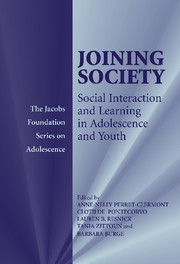Book contents
- Frontmatter
- Contents
- List of Contributors
- Foreword
- Preface
- I Introduction
- II Youth-Constructed Socialization
- III Personal Agency Through Collective Activity
- IV Learning in Practice and Discourse
- V Intergenerational Sites for Thinking
- VI Pathways to Adulthood in National Context
- 19 Joining Society in Europe: Convergence or Sustainability of National Specificities
- 20 The School-to-Work Transition: Problems and Indicators
- 21 To Be Young in Yugoslavia: Life After a Social Chernobyl
- 22 Youth and Unions in North America's Service Society
- 23 Joining Society: With What Certainty?
- Index
- References
21 - To Be Young in Yugoslavia: Life After a Social Chernobyl
Published online by Cambridge University Press: 08 January 2010
- Frontmatter
- Contents
- List of Contributors
- Foreword
- Preface
- I Introduction
- II Youth-Constructed Socialization
- III Personal Agency Through Collective Activity
- IV Learning in Practice and Discourse
- V Intergenerational Sites for Thinking
- VI Pathways to Adulthood in National Context
- 19 Joining Society in Europe: Convergence or Sustainability of National Specificities
- 20 The School-to-Work Transition: Problems and Indicators
- 21 To Be Young in Yugoslavia: Life After a Social Chernobyl
- 22 Youth and Unions in North America's Service Society
- 23 Joining Society: With What Certainty?
- Index
- References
Summary
The problem of transition from youth to adulthood has many different aspects. Among the numerous factors that determine it, Fouquet (this volume) concentrates on those that are most important: modes of access to employment and management of professional mobility, and the school and training systems. With respect to only these important factors, there are great variations among European countries, which are convincingly shown in collected statistical data. Clearly, youth have different transitional and integration problems in different countries, and differences in integration modes that exist among countries complicate their coordination with each other. In the first part of this chapter, I elaborate on some general sociopsychological aspects of growing up; in the second, I make some comparisons between Yugoslavia and countries mentioned in Foquet's chapter.
Fouquet's first sentence settles into a discourse in which youth is seen as something culturally constructed. And although, in lay psychology, some may believe that just waiting to reach a certain chronological age is all one has to do, that is not the right way to become an adolescent or adult. Although it is obvious that chronological age matters, it is not essential: The occurrence of significant events that correspond with it is what is really important. Not only the period of youth but also the whole age stratification can be viewed as socially constructed.
- Type
- Chapter
- Information
- Joining SocietySocial Interaction and Learning in Adolescence and Youth, pp. 300 - 307Publisher: Cambridge University PressPrint publication year: 2003



